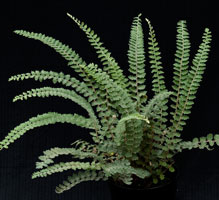11/26/2013
Xeriphytic Ferns: Green Texture for Dry Shade
Shanti Claycamp

While most ferns will tolerate periodic dry spells, there’s a large group of xeriphytic ferns that have adapted to dry areas where water supply and rainfall are limited. Many are native to the Americas. Casa Flora has been growing a few of these little-known ferns for many years. As fern specialists, we wanted to provide a fern that would fit into rock gardens and be able to tolerate the dryness that many other ferns could not. These little gems are unique and add interest to the landscape in many ways.
Pictured: Wavy Cloak (Cheilanthes sinuata) is native to the U.S. and performs well under low water conditions.
Cheilanthes is a genus of about 180 species of rock and cliff-dwelling ferns. They often grow in small crevices or in rock walls. Many of these are desert ferns and have fronds that curl up during times of drought and then revive when water is again readily available. Mostly evergreen, the genus name comes from the Greek words cheilos, meaning “lip,” and anthos, meaning “flower.” The genus Anemia also includes drought-tolerant ferns. With more than 120 species, ferns of this genus are often called “Flowering ferns.” Although they don’t produce real flowers, the spore-producing bodies are born on stalks that give the appearance of a flower and give rise to this name.
There are six main varieties:
Silver Cloak (Cheilanthes argentea)
Hairy Lip (Cheilanthes lanosa)
Wavy Cloak (Cheilanthes sinuata)
Wooly Lip (Cheilanthes tomentosa)
Mexican Flowering Fern (Anemia mexicana)
Hairy Flowering Fern (Anemia tomentosa)
The Silver Cloak Fern is native to Eastern Asia and tolerates drought by curling up its leaves to expose the bright metallic silver scales that coat the bottom of the leaves. This makes it quite a unique plant! The Hairy Flowering Fern is from the rocky plains of Argentina. The other varieties are all native to the U.S. and do well under low water conditions. The Mexican Flowering Fern is even reputed to be deer resistant!
Crop planning from 72-cell
Pot Size: Crop Time (weeks)
4 in. 12 to 14
6 in. 16 to 20
Temperature and zone requirement
Best growing temperature is 68F (20C) nights and 70F (21C) days. However, they continue to do well with daytime temperatures up into the 90s. Silver Cloak Fern and Hairy Lip Fern are both hardy to Zone 5, whereas the other varieties are native to the southern regions and are suited for Zones 8 to 11.
Media and pH requirement
These ferns require good drainage in gritty soil with organics added. A well-drained soil is a must to prevent root rot in these drought-tolerant ferns. All fern plugs should be planted so the crown of the plant is not covered with soil. This will help in preventing issues with the crown staying wet. Take care not to over water these unique ferns, as they need less water than a traditional fern. A pH of 5.5 to 6.5 is optimal for these little gems.
Fertilizer requirement
Light feeding (100 ppm N) with a balanced fertilizer will keep these ferns happy and thriving. Wavy Cloak Fern and the Wooly Lip Fern both have a wonderful bluish tint to them. Good fertilization will help keep them from looking gray.
Light levels
Cheilanthes and Anemia ferns are shade lovers, but these varieties can be acclimatized to higher light situations in the garden. Light levels between 1,300 and 1,500 foot candles produce optimum growth during production.
Disease and insects
Ferns in general have relatively low disease and insect problems, and these varieties are no exception. Good air circulation and careful watering can prevent fungal infections. The l
anosa, sinuata and
tomentosa varieties are very hairy and this protects them from most insect activity. Good scouting is the best defense because so few pests affect these plants. You’ll find that preventative treatments aren’t really necessary.
Casa Flora produces these ferns from spore. They’re perfect for shaded areas of rock gardens or other xeriscaping projects. They also work well in lower water areas of the landscape.
GT
Shanti Claycamp is a Fern Specialist and Growing Adviser for Casa Flora, Inc. based in Dallas, Texas.